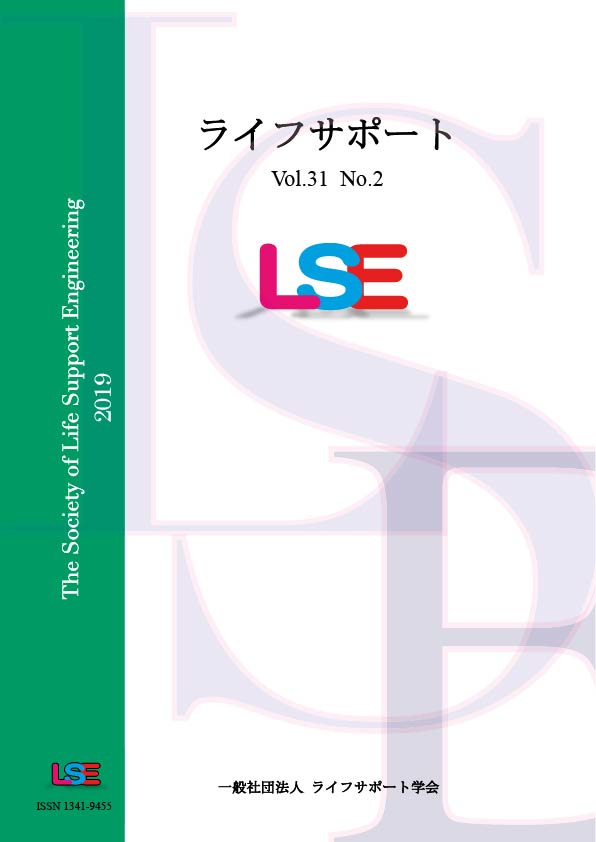
- Issue 4 Pages 143-
- Issue 3 Pages 93-
- Issue 2 Pages 49-
- Issue 1 Pages 1-
- |<
- <
- 1
- >
- >|
-
[in Japanese]2019Volume 31Issue 2 Pages 49
Published: June 28, 2019
Released on J-STAGE: February 11, 2021
JOURNAL FREE ACCESSDownload PDF (240K)
-
Yumi Mikami, Takabun Nakamura, Masaki Tauchi2019Volume 31Issue 2 Pages 50-57
Published: June 28, 2019
Released on J-STAGE: February 11, 2021
JOURNAL FREE ACCESSWe applied mobility restrictions on able-bodied subjects to simulate motor dysfunction and investigated the resulting effects on their wheelchair operation ability and mental state. The study simulated spinal cord injuries of the C8-T1 vertebrae. Each subject's torso was secured to a backsupport, while the soles of the feet were suspended. While these mobility restrictions were in place, the subjects ascended slopes at a variety of inclination angles, and we measured the motion, torque, and electromyogram during their wheelchair operations. As a result, applying the restrictions (1) increased handrim operating time, (2) reduced the backwards pulling motion by the upper arms, (3) suppressed trunk muscle activity, (4) increased the psychological burden during operations, and (5) resulted in balance being maintained by immobilizing the knee and ankle joints through the simultaneous operation of the vastus lateralis and gastrocnemius muscles because the torso could not lean forward. These results indicated that despite the compensatory motions, the mobility restricting method used in this study came close to simulating mobility difficulties.
View full abstractDownload PDF (649K) -
Takuya Kawai, Takahiko Yamamoto, Kohji Koshiji2019Volume 31Issue 2 Pages 58-63
Published: June 28, 2019
Released on J-STAGE: February 11, 2021
JOURNAL FREE ACCESSThis paper describes the design and development of an outer circumference figure-eight coil, which can be used in a high-frequency region for a totally-implantable artificial heart (TIAH). The transcutaneous energy and information simultaneous transmission system is useful for providing driving energy and controlling and monitoring TIAH. It is necessary to embed the energy transmission coil and the information transmission coil separately in the conventional system, increasing the treatment time and the implantation areas. We propose transformers for both energy and information transmission. The transformer for information transmission consists of two outer circumference figure-eight coils, which have a twice-wound outer circumference, for a tradeoff between increasing the frequency to adapt to the radio laws in Japan and miniaturization.
As a result, a smaller information transmission coil, which can be embedded in the body, with a diameter of 2.8 cm and operating at 429 MHz, is developed. The transmission characteristics between the transformer for information transmission is -12.14 dB. The energy transmission efficiency between the transformer for energy transmission is 84.4%. 1,000 characters of data can be transmitted without error when transmitting energy and information simultaneously.
View full abstractDownload PDF (1505K) -
Tsuyoshi Noro, Juhyon Kim, Tetsuya Fujita, Kazuki Nakajima2019Volume 31Issue 2 Pages 64-70
Published: June 28, 2019
Released on J-STAGE: February 11, 2021
JOURNAL FREE ACCESSAcquisition of daily urination information leads to accurate diagnosis and treatment of dysuria. Conventional uroflowmeters have some problems about installation cost, sanitation management and measurement condition. As a method to solve them, uroflowmetry by the bath scale was proposed. In this study, flow rate change was calculated from weight change and smoothed by moving average to remove effect of body sway. First, pseudo-urination was performed on the bath scale and an optimum number for smoothing was determined. Next, urination was performed on the bath scale, and it was measured simultaneously with a uroflowmeter. The accuracy of 5 measurements was examined with 7 subjects. As a result, the bell-shaped urinary flow patterns followed to the patterns of uroflowmeter. The estimated voided volume (VVest) and maximum flow rate (Qmax) distributed within ±20% of the reference.
View full abstractDownload PDF (1262K) -
-An Explorative Study to Detect the Area of Neglect in Near and Far Space-Ryoichi Kato, Kazuhiro Yasuda, Akinori Hagiwara, Shuntaro Kawaguchi, H ...2019Volume 31Issue 2 Pages 71-74
Published: June 28, 2019
Released on J-STAGE: February 11, 2021
JOURNAL FREE ACCESSUSN is one of the sequelae of stroke, and it is the failure to response or report to meaningful stimuli which are presented on the opposite side to a cerebral hemisphere lesion. These symptoms can exist for near and far spaces combined or independently, and it is important to provide evaluation system for near and far space neglect. Therefore, we developed the system which enable evaluate both near and far space neglect with immersive virtual reality (iVR), and we performed a validation study in USN patients. As a result, we realized to describe the aspect of USN in both near and far space. In this report, the applicability of an evaluation system using iVR is shown; however, the reliability and validity must be confirmed for groups, and proof of clinical usefulness must be established.
View full abstractDownload PDF (2606K)
-
[in Japanese]2019Volume 31Issue 2 Pages 75-76
Published: June 28, 2019
Released on J-STAGE: February 11, 2021
JOURNAL FREE ACCESS -
[in Japanese]2019Volume 31Issue 2 Pages 77
Published: June 28, 2019
Released on J-STAGE: February 11, 2021
JOURNAL FREE ACCESS
- |<
- <
- 1
- >
- >|